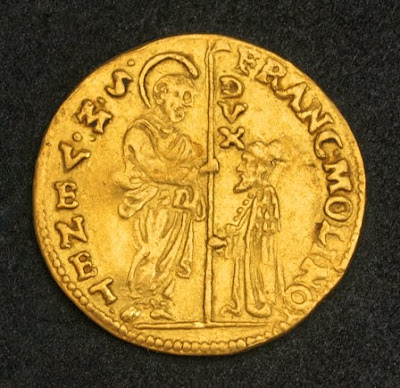Italian coins, Italian Coinage, Italian silver coins, Numismatic Collection, Coins of Italy best silver coins for investment, Italian Gold Coins, Italian States Coins, Coins of Italy, Coins of the Papal States, Gold coins of Italy, Vatican Coins, Vatican Gold Coins, Italian colonial coins.
the 99th Doge of Venice - Francesco Molin (1646-1655)
Reference: Gamberini 835, Friedberg 1318. R!
Diameter: 21 mm
Weight: 3.47 gram of gold
Obverse: St. Mark standing right, presenting cross topped banner (with small flag!) to kneeling Doge.
Legend: FRANC . MOLINO – S . M . VENET . / DVX (vertical along banner)
Reverse: Christ standing facing, raising hand in benediction and holding Gospels.
Legend: SIT . T . XPE . DAT . Q . TV – REGIS . ISTE . DVCA
Comment: Halo of light (mandorla) with 18 stars around.
Gold ducat of Venice
The Venetian business model of the 1200s was importing goods from the East and selling them at a profit north of the Alps. They paid for these goods with Byzantine gold coins but when the Byzantine emperor Michael VIII Palaiologos backed a rebellion called the Sicilian Vespers in 1282, he debased the hyperpyron. This was just one more in a series of debasements of the hyperpyron and the Great Council of Venice responded with its own coin of pure gold in 1284.Both Florence and Genoa had introduced gold coins in 1252 and the florin of Florence had become the standard European gold coin. Venice modeled the size and weight of their ducat on the florin, with a slight increase in weight due to differences in the two cities’ weight systems. The Venetian ducat contained 3.545 grams of 99.47% fine gold, the highest purity medieval metallurgy could produce.
Gold ducat types derive from silver ducat types, which were ultimately Byzantine. The obverse shows the Doge of Venice kneeling before St. Mark, the patron saint of Venice. Saint Mark holds the gospel, which is his usual attribute, and presents a gonfalone to the doge. The legend on the left identifies the saint as S M VENET, i.e. Saint Mark of Venice, and the legend on the right identifies the doge, with his title DVX in the field. On the reverse, Christ stands among a field of stars in an oval frame. The reverse legend is the same as on Roger II’s ducats.
Succeeding doges of Venice continued striking ducats, changing only their name on the obverse. During the 1400s, the value of the ducat in terms of silver money was stable at 124 Venetian soldi, i.e. schillings. The term ducat became identified with this amount of silver money as well as the gold coin. Conflict between England and Spain in 1567, however, increased the price of gold and upset this equivalence. At this point, the coin was called the ducato de zecca, i.e. ducat of the mint, which was shortened to zecchino and corrupted to sequin. Leonardo Loredan extended the coinage with a half ducat and subsequent doges added a quarter, and various multiples up to 105 ducats. All of these coins continued to use the designs and weight standards of the original 1284 ducat. Even after dates became a common feature of western coinage, Venice struck ducats without them until Napoleon ended the Venetian Republic in 1797.
Imitations of the ducat of Venice
When the Roman Senate introduced gold coinage either the florin or the ducat could have provided an advantageous model to imitate, but the Florentines who controlled the Senate’s finances ensured that their city’s coin was not copied. Instead, the Roman coin showed a senator kneeling before St. Peter on the obverse and Christ amid stars in oval frame on the reverse in direct imitation of the Venetian ducat. The Popes subsequently changed these designs, but continued to strike ducats of the same weight and size into the 1500s.Most imitations of the Venetian ducat were made in the Levant, where Venice spent more money than it received. The Knights of Saint John struck ducats with grand master Dieudonné de Gozon, 1346-1353, kneeling before Saint John on the obverse and an angel seated on the Sepulcher of Christ on the reverse. Subsequent Grand masters, however, found it expedient to copy the Venetian types more exactly, first at Rhodes and then on Malta. Genoese traders went farther. They struck ducats at Chios that could be distinguished from the Venetian originals only by their workmanship. These debased ducats were problematic for Venice, which valued its money's reputation for purity. The rarity of ducats that Genoese traders struck at Mytilene, Phocaea, and Pera suggests that Venetians melted those they encountered.

